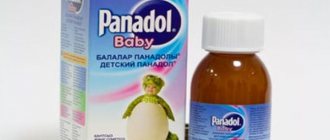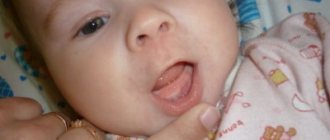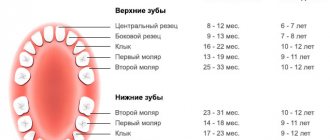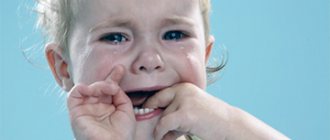Teething is an important process, which for many young children is accompanied by unpleasant sensations. Soreness, redness, and swelling of the gums at the site of eruption are signs of gingivitis. Inflammation of the gums during teething is a common phenomenon that every parent should be able to cope with. There are effective, safe remedies that will alleviate the child’s condition and quickly eliminate all symptoms of the disease.
Gingivitis during teething
Among dental problems in children, gingivitis ranks second after caries. Many people know that gingivitis is inflammation of the gums. It is highly treatable, but in order to distinguish gingivitis from other gum diseases (periodontitis, periodontitis, herpetic stomatitis), qualified assistance from a specialist will be required. So, what is gingivitis, what are its signs and why does this disease occur even in young children?
Symptoms of gingivitis in children
It is very easy to notice gingivitis in a child: all you need to do is pay attention to the following warning signs:
- inflammatory process manifested by bleeding gums;
- pain when brushing your teeth;
- itching in the gums;
- redness and swelling of the gums (small ulcers may appear on them).
Temperature during gingivitis appears only as a concomitant symptom when gingivitis occurs against the background of a cold or other infection, and cannot serve as the only symptom of this dental disease.
Gingivitis during teething
The main and most common cause of gingivitis in children is insufficient oral hygiene. In addition, reduced immunity, the presence of carious teeth, malocclusions, mechanical injuries to the oral cavity, wearing braces, hormonal diseases and more contribute to the development of the disease. However, the listed reasons are indirect; all of them, to some extent, contribute to the deterioration of dental hygiene or the accelerated formation of plaque on them.
Teething also occurs as a cause of gingivitis. This applies to the eruption of both permanent and baby teeth, especially if this process is prolonged and causes pain when brushing. At the same time, the child tries to spare the tooth as much as possible, poorly treating this place during daily hygiene. The result is the accumulation of microbial deposits in the spaces between the teeth, the appearance of plaque, redness and swelling of the gums. In some cases, teething itself can cause the development of gingivitis. If a cutting tooth injures the mucous membrane of the gums, and an infection gets into the wound, the child may develop ulcerative gingivitis. Try to control how thoroughly your child brushes his teeth during the teething period, and if symptoms of the disease appear, be sure to consult a dentist.
How to treat gingivitis in children?
Treatment of gingivitis in children is simple. Most often it consists of the following measures.
- A trip to the dentist to make a diagnosis and choose a treatment regimen.
- Professional hygiene procedure: it consists of removing plaque and tartar, if any, using ultrasound.
- If necessary, dental sanitation is carried out, that is, treatment of teeth affected by caries.
- The next stage is to relieve inflammation: for this, gingivitis is achieved by rinsing with antiseptics (miramistin, chlorhexidine, infusions of medicinal herbs - sage, eucalyptus or chamomile). For young children whose baby teeth are emerging, the doctor may recommend using medicinal gels or ointments for the gums (Cholisal, Metrogyl Denta and others).
- Subsequent prevention of gingivitis, consisting of thorough brushing of teeth and proper nutrition (carbonated water and sweets, as well as frequent snacks, are excluded).
Treatment of gingivitis in children at home with all kinds of folk remedies is unacceptable.
Without preliminary sanitation, all rinses and ointments used independently will not give the desired effect and, at best, only relieve symptoms that will soon return. Left untreated, it can lead to other, more serious oral diseases. Inflammation spreads to healthy gum tissue, and the child may develop periodontitis or a chronic form of gingivitis. To avoid such complications, do not neglect the treatment of dental diseases!
Gingivitis in children: is there any cause for concern?
Gingivitis is an inflammation of the gums, a periodontal disease, which, unfortunately, very often occurs in young children. The reasons for this can be located both in the oral cavity and in the baby’s body.
Children may experience the following forms of gingivitis:
- catarrhal;
- hypertrophic;
- ulcerative;
- herpetic;
- eruption gingivitis.
Types of inflammatory processes
Gingivitis
Inflammation of the gums at the initial stage, that is, not yet spreading to the bone tissue, is called gingivitis.
Treatment of gingivitis in children follows the same principle as in adults, with the only difference being that children are prescribed more gentle medications. When starting the procedure, the hygienist performs professional cleaning, removing plaque and stone, after which he teaches the little patient proper hygiene techniques. Helps you navigate the selection of toothpaste and brush.
Periodontitis
Inflammation of the gums and periodontal tissues - periodontitis - is an advanced stage of gum disease. If left untreated, its progression may result in one or more teeth having to be removed.
Treatment includes occupational hygiene and physical therapy. If the process is advanced, surgical intervention may be required.
Periodontal disease in children
The defeat of all periodontal tissues, in this case, is called childhood periodontal disease. This degree is quite rare. Progression can be triggered by weakened immunity and vitamin deficiency.
An effective option in this case is surgical intervention, as well as strengthening the general condition of the body.
Stomatitis in children
Infectious inflammation of the mucous membrane of the gums, or stomatitis, is characterized by increased sensitivity and discomfort while eating. Therefore, you should show it to a dentist as soon as possible. A dental clinic specialist will examine the baby and prescribe appropriate procedures.
Gingivitis in children: causes
The causes of the disease are usually divided into general and local. Local reasons include:
- insufficient hygiene;
- abnormalities in the attachment of the frenulum of the lips or tongue;
- malocclusion;
- the presence of pathogenic microflora in the oral cavity;
- reduced immunity;
- changes in the composition of saliva.
Common factors include somatic diseases, one of the first manifestations of which may be gingivitis:
- diabetes;
- decreased or increased thyroid function;
- childhood neuropathy;
- heart diseases.
Read also: Why children grind their teeth in their sleep reasons
If gingivitis occurs, you should not immediately suspect these diseases, but you need to take your baby to the doctor for a correct diagnosis.
Symptoms of gingivitis in children
Symptoms of gum inflammation will depend on the form of the disease. But all of them will have:
- redness;
- edema;
- soreness;
- increase in gum size;
- bleeding
With severe gingivitis, the general condition may be disturbed: weakness, anxiety, increased body temperature.
Catarrhal gingivitis in children
It can occur due to insufficient care of teeth and gums. Sometimes young mothers do not know that immediately after the baby’s teeth erupt, they need to be gently cleansed. In this case, the gums will be slightly increased in size, hyperemic and painful when touched. There is a lot of dental plaque.
Hypertrophic gingivitis in children
With hypertrophic gingivitis, gum overgrowth occurs. This type of disease can manifest itself in an edematous and fibrous form:
- With edematous gums, the gums are large, red, bleeding, and painful when brushing your teeth.
- In the fibrotic form, the gums are enlarged in size and may cover a significant part of the tooth, but they are of normal color and do not bleed.
Ulcerative gingivitis in children
May develop after acute catarrhal gingivitis. This type of disease develops when the body’s defenses decrease and the presence of fusospirillary symbiosis in the oral cavity. Signs of the disease:
- pain and itching of the gums;
- hyperemia;
- the appearance of ulcerations along the gingival margin;
- formation of ulcers and areas of necrosis on the gums.
Ulcerative gingivitis is the most serious, lasts a long time, is accompanied by intoxication and a violation of the general condition.
Herpetic gingivitis of children
It can manifest itself as an independent disease or occur with herpetic stomatitis. Acute herpetic stomatitis is a disease of the oral cavity that is observed in many children when the herpes virus first enters the body. Signs of gingivitis will include:
- the appearance of blisters and ulcers on the gums;
- edema;
- hyperemia;
- strong painful sensations.
All this against the background of rising temperature, enlarged submandibular lymph nodes, anxiety and whims of the child.
Eruption gingivitis in children
It can occur in children while teething, from 6 months to 2 years. This is the only type of gingivitis in which dental hygiene does not play a role. When the disease occurs, the gums become swollen, red, and experience minor pain. Gingivitis disappears with teething.
Sometimes it may seem that with gingivitis, a child’s teeth turn blue; in fact, this is inflammation of the gums and the formation of a microhematoma (during eruption, the tooth touched a vessel). Microhematoma does not require treatment; it will resolve over time.
Acute gingivitis in children
Acute gingivitis in its clinical picture will resemble acute catarrhal gingivitis:
- swelling occurs;
- pain;
- redness;
- dysfunction of the gums.
This type of gingivitis occurs in acute infectious diseases (measles, ARVI, scarlet fever, diphtheria). Disappears when treating the underlying disease.
Gingivitis in children under one year of age
In children under one year of age, teething gingivitis, catarrhal acute gingivitis and herpetic gingivitis may occur. If symptoms of the disease occur, you should contact your pediatrician and pediatric dentist. The earlier treatment is started, the better the prognosis of the disease.
Treatment of gingivitis in children
Treatment is based on finding and eliminating the cause of the disease. Treatment of diseases of internal organs and increased immunity is carried out by a pediatrician, and a dentist carries out sanitation of the oral cavity.
If the child is over a year old, the doctor cleans the teeth, teaches the rules of oral hygiene, and gives recommendations on the use of brushes and toothpaste. Next, he treats the gums with antiseptic and antimicrobial drugs, and applies anti-inflammatory drugs.
If necessary, prescribes antiviral, anti-inflammatory drugs, physical therapy, surgical or orthodontic treatment.
Treatment of gingivitis in children under one year of age
Treatment should be carried out by a pediatrician or dentist. Therapy consists of carefully cleansing the first teeth of plaque, treating the gums with herbal decoctions or weak antiseptic solutions. There are also special dental gels and ointments for treating gingivitis in children.
Gingivitis in children is a common disease. It can arise either for a trivial reason (lack of hygiene, teething) or develop into a serious systemic disease. For adequate treatment, you must seek help from a doctor.
Liana Mokhtari, dentist, especially for Mirmam.pro
Useful video
Inflammation of the gums in a small child
Gum inflammation in children is a big problem for young parents. Gums become red and swollen for several reasons. The most common cause of inflammation in babies is teething. Children from the age of three are at risk of developing gingivitis.
You can help your child cope with painful teething symptoms at home using topical medications. If in doubt, it is better to ask your pediatrician for help. Gingivitis can be treated under the supervision of a pediatric dentist.
Read also: Prevention of oral thrush in newborns
Inflammation of the gums with bleeding due to gingivitis
Symptoms of gum inflammation
The first problems with teeth begin in a person in infancy, when these same teeth come out. They continue into preschool age, when you want to put everything in your mouth, but you don’t like brushing your teeth at all. Schoolchildren's baby teeth change, which is also accompanied by troubles.
It is not difficult to notice gum inflammation in a child. The condition is accompanied by the following symptoms:
- Redness. It can be localized in one place or spread over the entire surface.
- Swelling. The inflamed area of the gum increases in size. In some forms of gingivitis, a growth may appear on the gum.
- Pain. During teething, repeated pain causes the baby to cry and be capricious. Inflammatory gum disease is most often characterized by aching pain.
- Itching, burning. There is a desire to scratch the sore spot.
- Increased body temperature. The child's temperature rises to 38 degrees.
- Bad breath. It rarely appears during teething and serves as a sign of infection. A strong odor from the mouth is characteristic of advanced gingivitis.
In infants, gum inflammation is more difficult to detect, because the infant cannot yet complain of pain.
Inflammation of the gums - gingivitis
Parents often associate moodiness and fever with a cold. Older children can talk about their condition.
You can examine your child's mouth at home. Before doing this, you must wash your hands with soap. Then you can try to relieve redness and swelling using local remedies. It is best to discuss the use of any medications for an infant with a pediatrician.
Treatment of gums in children
Medicines prescribed by a doctor have analgesic, antibacterial and anti-inflammatory effects. They help restore the proper condition of the mucous membrane. Methods of using drugs are different, but the principle is the same: rinsing, irrigation.
For gum disease in infants, the dentist will prescribe special gels to relieve symptoms, namely itching and pain. Parents should pay special attention to cleaning their mouths from food debris.
Antibiotics are prescribed by a dentist in rare cases. Indications for the use of antibiotics is a form that reaches a complex (ulcerative-necrotizing gingivitis) or chronic stage. Antibacterial or antifungal drugs are prescribed when the problem is caused by an infectious process, and the goal is to eliminate its causative agent.
Gums during tooth eruption
The timing of the eruption of baby teeth in children is strictly individual. Some have their first tooth at 3-4 months, while some still have an empty mouth at one year old. The process of teething ends in a child at 2 years old.
The baby holds his fists in his mouth, puts toys in, and salivates profusely. These are the first and main signs of teething. Caring parents should give their baby a silicone teether during this period.
The appearance of the first teeth is also accompanied by symptoms:
- Increase in body temperature to 38 degrees.
- Loss of appetite.
- Irritability.
- Restless sleep.
Due to increased salivation, the baby may develop a cough, runny nose, and irritation of the skin around the lips.
Redness of the gums is observed at the site where the baby tooth erupts. A bump is visible on the surface. If you touch it with your finger, you can feel the sharp edge of the tooth.
The lower incisors appear first, followed by the upper ones. In one-year-olds and 2-year-old children, molars erupt. The appearance of molars is a longer and more painful process.
How to help your baby during teething
The appearance of teeth is a very difficult and worrying stage in the life of babies and their parents. The child experiences severe pain and discomfort. You can alleviate your baby's condition at home.
- Modern medicine offers many means and methods that will relieve a child of suffering during the appearance of teeth:
- Gum massage. The method helps relieve itching and pain and speed up the process of tooth eruption. You can use simple gauze to massage your gums. It is moistened in water or chamomile decoction, wrapped around a finger, and moved lightly along the gum. Special silicone finger pads are also used for massage. They can be purchased at any pharmacy.
- Use of local anti-inflammatory drugs. Gels and ointments with herbal ingredients are widely used. For newborns it is recommended to use “Baby Doctor, First Teeth”. For children over 6 months old, you can use Kalgel with lidocaine, Cholisal and Dentinox.
- Oral use of anti-inflammatory drugs. You can bring down your child’s temperature and relieve pain with the help of children’s “Nurofen” in a convenient suspension form. The drug can be used in children from three months of age.
Teething - inflammation
Some herbal preparations can cause allergies in a child. If a rash or swelling of the mucous membranes appears, you should stop taking the drug and contact your pediatrician.
During teething, special attention should be paid to the baby's nutrition. You should not give sweetened drinks to avoid the development of caries. You also need to pay attention to hygiene. The baby's tongue should be cleaned with moistened gauze in the morning. All procedures should be carried out only with clean hands.
Teething aids
Gum atrophy
A rather unique and rare disease - gum atrophy or exposing atrophic gingivitis manifests itself as itching in the area of 2, less often 4 and 6 symmetrically located milk teeth. A child experiencing discomfort constantly rubs the area of inflammation. At night, the itching usually intensifies.
The interdental papillae and other areas of the gums do not change in any way during gingival atrophy. Slight deposits of tartar are often observed on the unprotected root surface.
The manifestation of itching can be a consequence of measles or influenza, despite the fact that in most young patients such a relationship is not observed. The process of teething is also one of the factors causing itching in infants.
Inflammatory gum disease in children
Gums can become inflamed in newborns and adult children. The most common causes of gum disease:
- improper oral hygiene;
- nutritional deficiencies (lack of vitamins and microelements);
- problems with nasal breathing;
- infectious diseases.
Read also: Treatment of stomatitis in a child
Insufficient oral hygiene creates a favorable environment for the development of bacteria. During infectious diseases, pathogens enter the oral cavity from parts of the respiratory system. If nasal breathing is impaired, the child begins to breathe through the mouth. The mucous membranes dry out, and the antibacterial function of saliva is impaired. This leads to active proliferation of microorganisms.
Causes of gum inflammation
Sometimes gum inflammation in young children is associated with eating soft foods. There is no chewing load on the gums. When teeth appear, it is necessary to give the child solid food - apple slices, pears, bread crusts.
Causes of gum inflammation in children
- Skipping or poor quality teeth brushing;
- Sucking dirty objects;
- Errors when installing seals;
- Pathologies of the dentition;
- Carious cavities with sharp edges;
- Bite correction;
- Breathing through the mouth;
- Abnormal structure of the oral cavity organs (attachment of the frenulum of the tongue and lips);
- Problems with the functioning of the cardiovascular system;
- Disruption of the gastrointestinal tract;
- Infectious diseases (ARVI, influenza);
- Hormonal abnormalities;
- Hereditary anomalies.
Gingivitis in children
Children from 3 to 6 years old constitute a separate risk group for developing gingivitis. This is an inflammatory disease of the gums of moderate severity, which does not damage the dental and periodontal tissues. The development of gingivitis in children is associated with poor hygiene and vitamin deficiency.
Gingivitis can occur acutely or chronically. Acute gingivitis is also called catarrhal. There are several forms of chronic gingivitis:
- marginal (simple);
- hypertrophic;
- atrophic;
- desquamative;
- ulcerative
In childhood, marginal gingivitis most often occurs. A red growth on the gums of a child may indicate the development of hypertrophic gingivitis. Gum tissue grows in the interdental space. Chronic gingivitis can be asymptomatic for years with periodic exacerbations.
A pediatric dentist will tell you what to do if a child has gingivitis. Symptoms of inflammation can be relieved on your own.
Diagnosis of gum disease in children
A routine oral examination should be performed by a pediatric dentist every six months. And as necessary, if a small patient exhibits any deviations in the development of teeth or symptoms of disease of the oral mucosa. Since it is advisable to diagnose the inflammatory process at the earliest stage.
If redness, swelling and bleeding are detected, the cause of which is an excessive amount of soft plaque or food debris on the teeth, the dentist will make a diagnosis and prescribe procedures.
If a bacterial infection is suspected, a clinic specialist can take biomaterial from the inflamed areas of the gums for clinical tests. Based on the results of the analysis, the specialist prescribes a treatment plan and the date of the next appointment to ensure the final recovery of the little patient.
Symptoms of acute gingivitis in a child
In acute gingivitis, the symptoms of inflammation are pronounced. The gums around the tooth turn red. Bleeding occurs when brushing teeth or chewing hard food. The child feels pain, is capricious, and may refuse to eat. In rare cases, an increase in temperature is observed.
The gums near the tooth are swollen and hurt
How to treat acute gingivitis:
- Chamomile decoction. Older children can rinse their mouth. For babies, the gums are treated with moistened gauze.
- Anti-inflammatory ointments and gels. They help get rid of red gums and relieve swelling.
- Antipyretics and painkillers. Use only for severe inflammation.
During treatment of gingivitis, it is necessary to exclude sweets from the child’s diet.
It is necessary to clean your teeth and tongue of plaque twice a day. The procedure is carried out with cotton swabs.
When a child's gums become inflamed, you can give him a decoction of chamomile and sage. All medications are used according to the instructions, taking into account contraindications.
Preventive actions
The best prevention of inflammation of the mucous membrane is daily and high-quality hygiene from an early age and proper nutrition.
Hygiene
The concept of “quality hygiene” includes brushing your teeth at least twice: in the morning and in the evening, in conjunction with cleaning the palate and tongue.
Parents should take a very responsible approach to hygiene from the day the first tooth appears. And after he grows up a little, learn the rules of brushing his teeth: regularly and efficiently. The toothbrush and toothpaste should be selected according to the age of the small patient.
Nutrition
In addition to hygiene, parents need to approach the diet wisely: it should be balanced and include vitamins and minerals. Sweets and carbonated drinks should be consumed by the child in limited quantities. In addition, after finishing eating sweets, the baby should rinse his mouth with water and, if possible, brush his teeth. Note that a diet that promotes the proper development of a growing body includes nutritious and timely meals. Snacking and disordered eating should be kept to a minimum.
Acute herpes stomatitis
Stomatitis is inflammation of the oral mucosa. The disease occurs when pathogenic microorganisms enter the mouth. Herpes stomatitis often occurs in children aged 1 year when the herpes virus first enters the body.
The disease can occur in mild, moderate and severe forms. Stomatitis is accompanied by acute gingivitis. Main symptoms of the disease:
- An increase in body temperature to 37-38 degrees in mild cases, up to 40 degrees in severe cases.
- Enlarged lymph nodes.
- Nausea, vomiting, diarrhea.
- Anxiety.
- Reddened gums.
Stomatitis on the gum
Inflamed gums with herpetic stomatitis become very swollen and increase in size. Tissues can cover the dental crown to the middle.
Treatment is carried out as prescribed and under the supervision of a doctor. Antiviral, antihistamine, antipyretic drugs and vitamins are prescribed. To correct the functioning of the digestive system, sorbents and enzyme preparations are prescribed. The oral cavity must be treated with local anti-inflammatory and healing agents.
https://youtu.be/hc916bn0N9I
Treatment of children at RAIDEN
In the RAIDEN network of dental clinics, the treatment and prevention of oral diseases of young patients is treated with the utmost attention and reverence - the health of the younger generation is very important to us!
All medications used in our clinic meet the highest quality requirements. Before using them, we conduct a blood test of the baby to determine drug tolerance. The safety of your children, our little patients, is paramount to us.











